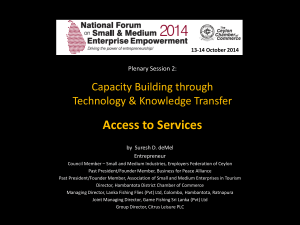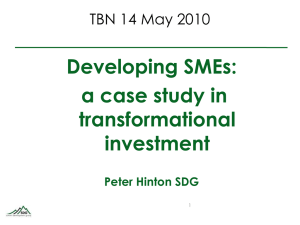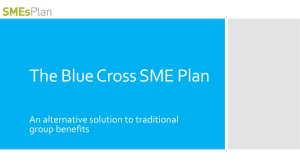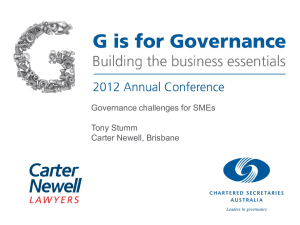yr_11_bus_studies_business_planning_pt_3_180711
advertisement
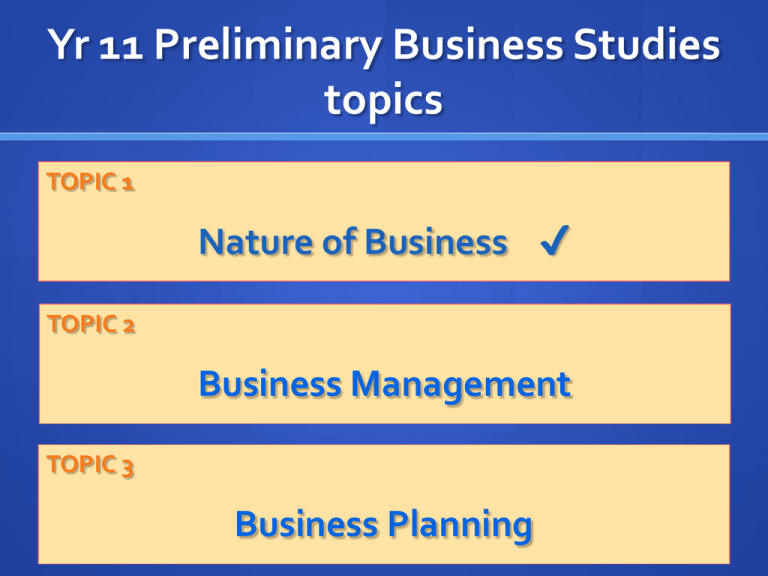
Yr 11 Preliminary Business Studies topics TOPIC 1 Nature of Business ✔ TOPIC 2 Business Management TOPIC 3 Business Planning TOPIC 3 Business Planning Yr 11 Preliminary Course Part 3 The focus of this topic is: The processes of establishing and planning a small to medium enterprise What we will cover …the Syllabus Students learn to Examine contemporary business issues Investigate aspects of businesses using hypothetical situations and actual business case studies Prepare a small business plan Students learn about Small to Medium Enterprises (SME’s) Influences in establishing SME’s The business planning process Critical issues in business success and failure The 4 main topics in Business Planning are: Small to Medium enterprises (SME’s) Influences in establishing SME’s ✔ Completed ✔ Completed The business planning process Critical issues in business success and failure We are now up to part 3 in this topic Small to Medium enterprises SME’s ✔ Completed Influences in establishing SME’s ✔ Completed The business planning process Critical issues in business success and failure The Business Planning Process covers… 1. The Role of the Business Plan 2. Business Planning Process 3. Sources of Planning Ideas 4. Vision Statement 6. Organising Resources 5. Goals/Objectives 7. Forecasting 8. Monitoring & Evaluating 9. Taking Corrective Action Modification You wouldn’t go on a year long trip around Australia without firstly planning the trip! The business plan is like a road map It plots the route the business will travel Activity: Planning Your ‘Schoolies’ Holiday! Imagine you are taking ONE month trip around Australia with your friends as part of your end of Year 12 “Schoolies” holiday Write down all the things you would need to organise before and on the trip “Learn the Lingo” first! Term Definition Business Plan A plan for a business, a written document Planning The process of setting targets and deciding how to achieve them. SWOT Analysis A technique for gathering information for use in the business plan. SWOT stands for strengths, weaknesses, opportunities and threats Vision Statement Broadly states what the business aspires to become; its purpose and its function. Objectives Specific statements detailing what a business needs to achieve in order to accomplish its vision Strategic Goals These goals focus on long-term, broad aims and apply to the business as a whole. Usually set by senior management Tactical Objectives Middle management set tactical objectives. These focus on mid-term, departmental issues and describe the course of action necessary to achieve the business's strategic goals. Operational Objectives Front-line managers or supervisors set operational objectives. These focus on short-term issues and describe the course of action necessary to achieve the business's tactical objectives. “Learn the Lingo” first cont. Term Definition Social Justice A business adopts a set of policies to ensure that employees or other community members are treated equitably and fairly Organisational Structure How tasks are divided and resources used in a business Resource Allocation The efficient distribution of resources so as to successfully meet the goals that have been established. Forecasts Forecasts (or projections) are the business's predictions about the future. Break Even Analysis Break-even analysis determines the level of sales (revenue) that needs to be generated to cover the total cost of production Budget A budget is the business's financial plan for the future. The Role of the Business Plan The first task of anyone wanting to commence a business is to undertake thorough planning. The planning will provide the foundation on which the business will be built. Strong, firm foundations will usually result in a successful business. What exactly is the business plan? EXACTLY THAT = A plan for a business It is a written statement of the business’s goals and the steps to be taken to achieve them It is a summary and an evaluation of a business idea in written form It is a ‘living document’/working document A comprehensive business plan will assist when arranging finance for the business Activity: Page 393 in your text Read the case study Answer the Ques 1- 4 The main reasons for business owners’ failure to plan Role of the business plan cont. Types of Business Plans: No TWO businesses are the same Neither are TWO business plans A business plan for a TNC (Global company) will be detailed and comprehensive. It will add up to hundreds of pages, having taken much time, effort and money to prepare. Its presentation will be highly professional and distributed to a large number of the company's senior management. A business plan for a SME may be only 10–15 pages in length, word processed at home and circulated to only a few people. Role of the business plan cont. Depending on variables such as the product, the market, the size of the business and its location, each business will have a unique set of information in its business plan Regardless of their type, length, appearance and distribution, all business plans have a number of common elements Activity: Unjumble the business plan In groups of 4 Place the headings in the correct order Note: not all are headings, some are sub headings! You’ve got 10 minutes Common elements of the business plan Example Executive summary Operational, Marketing, Organisational, Financial Plans Benefits of a business plan Benefits of a business plan cont. The written plan becomes a useful reference point for the running of the business. Any small business with a plan has direction, which ultimately saves money, time and effort, and also increases the likelihood of success. Preparing a business plan is very similar to completing an assessment task. The result will reflect the amount of time, effort and research that goes into the plan and its final presentation. Business Planning Process Planning is a process, a series of actions to achieve a goal For example – if you decide to have a party Saturday night, this is your goal. Unless you undertake some planning you will be unable to achieve this goal. You will need to invite people, organise food, drink, music and choose a venue. These tasks are the series of actions, an action plan, that you need to undertake to achieve the goal. Business Planning Process A business plan is far more than just listing ideas The business plan needs to analyse the whole business by examining ALL parts of the operation. As a result , each part of the business can function effectively and achieve its goals. Party Action Plan! Identify the most appropriate words from below to complete the following sentences plan review flexible strengths costs goals direction link fail loan Businesses do not plan to __________, they fail to __________. Business plans should be _____________ — that is, modified as conditions change. A business owner should regularly _____________ the business plan and modify it when the business environment changes. Without a business plan the business lacks _____________. Many business owners do not prepare a plan because they think it _______________ too much. When reviewing an application for a _____________, financial institutions will want to examine the business plan. __________________ are what you want to achieve. A business plan helps identify the business's ______________ and weaknesses. The planning process is the __________ between the owner's ideas and the actual operation of the business. Sources of Planning Ideas We have already examined how the business environment is divided into two categories: • the internal business environment This covers the factors within the direct control of the owners. It represents what occurs within the business. • of the external business environment. This is the larger environment within which the business operates. It consists factors over which the business has little control, and represents what occurs on a larger scale outside the business A SWOT Analysis is an excellent technique for gathering information for use in the business plan and can be used at all stages of the planning process. SWOT is a technique for gathering information Vision Statement The vision statement broadly states what the business aspires to become; its purpose and its function. The vision of the National Australia Bank, for example, is ‘we will be a leading international financial services company which is trusted by you and renowned for getting it right’. Vision statements are sometimes called mission statements. The two terms are often used interchangeably. Vision Statement Purpose of the vision statement The main purpose of the vision statement is to guide and direct the business owners, managers and employees. It creates the culture within the business and acts as a benchmark against which to measure all the business's decisions and operations. Goals/Objectives Once the owner has formulated the vision statement for the business, they can determine specific goals. People start up a business because they want to achieve something; they have a goal they want to accomplish. A goal states what a business expects to achieve over a set time, which will assist in realising the business's vision. Goals for businesses could include the following: to become the largest business in the market to improve market share to provide a reasonable return for investors to contribute to the wellbeing of the community. All these goals have one thing in common: they are the motivating force behind the business. Goals/Objectives The objectives established at each layer of the business's hierarchy are devised with the purpose of helping to achieve the strategic goal. Goals/Objectives ACTIVITY: Let’s come up with our own Vision, Goal, Objective on the board Financial Goals All businesses have financial goals and a system of financial record keeping. Financial records are also used to determine a business’s level of success in achieving its financial goals. The 4 main financial goals are: Profit Market Share Growth and diversification Share price 4 financial goals Profit This is what remains after all the business’s expenses are deducted from the sales revenue TR = Total Revenue TC = Total Cost TR – TC = Profit Growth & Diversification Many businesses wish to grow and expand. Many SME’s have done so. e.g. Michel’s Patisserie. In 1988 Carroll and Roberts came up with the concept of a central bakery baking the product and distributing daily to retail outlets who in turn sell to customers. Now there are over 340 stores throughout Aust and NZ, and it’s the largest franchise group of its kind. Market Share Is the business’s share of the total industry sales for a particular product. e.g Pepsi has approx 10% share of the $1.8billion carbonated soft drink market Share Price Business’s that wish to be successful need to maximise the returns of their shareholders. This is achieved by keeping the share price rising and paying back healthy dividends. Social Goals All businesses operate within a community and like individuals they have certain social responsibilities. Some businesses develop social goals and adopt strategies that will benefit the community whilst still achieving financial goals. These are the main social goals Community service Provision of employment Social justice Ecological sustainability ACTIVITY: Find a definition and example Social Goal Community Service Provision of employment Social Justice Ecological Sustainability Definition Example Personal goals of managers/owners Fill in the missing words Business owners normally have a _______of personal goals. Often the nature and _____________of the business tend to reflect these personal goals, especially in SMEs. The personal goal of achieving _________ ________and greater_______ __________, for example, will complement the business goals of growth and diversification. Personal goals for business owners are not __________included in the business plan or mission statement. However, this does not diminish their importance, because they __________ the business owner and may underpin the __________of the SME. normally number higher income operation financial security viability motivate Long Term Growth Is the ability of a business to continually expand It is using the business’s asset structure to increase sales, profits and market share. It is an important goal of management as it ensures that the business is sustainable into the future. Most businesses grow on their own, but this growth can be accelerated with the assistance of good planning and sound strategies. Long term growth plans Myer, for example, recently put in place a number of strategies to increase profit maximisation to help guarantee its long-term growth. The strategies included a: price discounting tactic to entice customers into its stores targeted promotional sales of exclusive brands that have high profit margins streamlining of its logistics systems concentrated effort to reduce shoplifting with the installation of security cameras. Other strategies to achieve long term growth are Customer feedback. Google, the internet's number one search engine, continuously and rapidly upgrades its operating system by listening to its customers. Supplier and customer partnerships. Bridgeport Manufacturing provides customers with the opportunity to develop products in consultation with the business's designers. Product innovation. Zentech Computers focuses on bringing three new products onto the market every six months by undertaking constant research and development. Sigma Six. This business management approach, originally developed by Motorola and used extensively in all types of businesses, aims to improve business performance by improving quality, reducing costs and creating new opportunities. A sigma six process is one in which 99.99% of all manufactured products are defect free. Organising Resources Once the SME owner has formulated the vision, goals and objectives, then he/she MUST organise the resources Human effort, time, money, equipment, materials – all needed to fulfil the plan Organising is determining: WHAT IS TO BE DONE WHO IS TO DO IT HOW IT IS TO BE DONE The owner must determine all the activities that employees perform from ordering stock through preparing financial reports to meeting with clients and all the equipment, money and facilities that employees need to carry out those activities. This results in the creation of an organisational structure. Organising Resources an organisational structure defines how tasks are divided and resources used Defining the vision, goals Determining the activities Grouping the activities into 4 key functions Assigning the activities to staff Designing a hierarchy of relationships Part of the organising process requires resource allocation The efficient distribution of resources to meet the goals of the business Business Owner Operations Marketing Finance Human Resources Each of the 4 key business functions require specific resources that need to be effectively organised Organising Resources Benefits of a properly implemented organising process are: establishes a chain of command that results in an orderly way of communicating within the business creates a coordinated work environment by outlining sensible guidelines for who does what and who is responsible for various activities provides a sense of common purpose so that all employees are working towards a common vision, goal or objective organises resources in the most efficient manner so that all employees can perform their tasks. Operations Is the transforming of different types of inputs i.e raw materials, labour, equipment and other resources into finished or semi finished goods and services Other wise known as ‘production’ Questions such as these need to be addressed What type of equipment and raw materials are needed? Which suppliers will be used to purchase the equipment and raw materials? How much money needs to be allocated for the purchase of the raw materials and resources? What storage, warehouse and delivery systems are required? What level of technical expertise will employees need to achieve maximum production from the raw materials and equipment? Marketing • Is made up of the product, price, promotion and distribution of goods/services and a clearly defined target market (customer). • Marketing is NOT just selling or advertising A marketing plan will only succeed if all sections of the business are involved in satisfying a customer's needs and wants, while achieving the business's goals. This means that the marketing plan needs to become integrated into all aspects of the business. The efforts of all employees in the marketing department must be coordinated and this is best achieved by adequate resourcing. For example, the sales consultants, advertising personnel, market research staff, distribution people and so on must be provided with the informational, financial and physical resources to perform their jobs. Finance New business ventures, even micro ones, require funds to operate. In organising the financial resources, one of the most important questions the SME owner needs to answer is ‘What will be the most appropriate source of financing?’ The most common sources are personal savings and/or loans from family, friends or banks. For example, Megan Pearce started her business ‘Megan's Marketplace’ with a $15 000 loan from the National Australia Bank and $12 000 borrowed from her sister. Another important issue associated with organising finances is the amount of equity (ownership of the business) and potential control a SME owner must hand over to obtain the necessary financing. If the SME owner decides to fund the business by using equity capital, the investor will be given some form of ownership in the business. Frequently, SMEs that are aiming for relatively moderate growth use mainly debt capital with the owners retaining most or all of the equity. Finally, when organising the financial resources, the SME owner must explore the wide range of federal and state government grants — any monetary or financial assistance that does not generally have to be repaid — and other funding programs. Generally, there are no grants for starting a business. Grants are usually provided for: expanding a business, research and development, innovation and exporting. Human Resources Of course, new business ventures often require the help of others — employees — besides the entrepreneur or SME owner. Since each employee in a SME represents a large percentage of the business's workforce, a specific individual's contribution can be especially important to the success of the business. Employees are a SME's most important resource. A great deal of care and thought, therefore, needs to be given to how best to organise this crucial resource. SME owners need to use good recruitment and selection processes to find employees who will be invaluable assets as the business grows and expands. Another important aspect all SME owners need to consider when organising their human resource arrangements is the need to comply with legislation relating to anti-discrimination and equal employment opportunities. The retailer Myer, for example, was able to retain valuable employees when it introduced a policy of six weeks paid maternity leave for staff who had worked a minimum of 18 months. Activity: Pizza for Lunch! Imagine you have been asked to make fifty family-sized pizzas for a celebration lunch. You have five people to help with the task. In groups of 2: Identify the resources you would need to make the pizzas. Classify the resources as either (i) raw materials, (ii) equipment or (iii) knowledge. Demonstrate how you would allocate the resources. Forecasting A business needs more than just information about present business conditions. It also needs information about possible future events. Forecasts (or projections) are the business's predictions about the future. Students sometimes forecast the results they hope to achieve in an assessable task. But just like weather forecasts, what is predicted and what actually happens may be quite different! Nevertheless, forecasts are needed to enable effective planning. An owner may need to forecast the availability of labour, raw materials, finance and building requirements. For this task, business owners rely on internal and external information sources. One very useful set of data is the forecast for total revenue and total cost. Total Revenue (or Sales) A SME owner can attempt to forecast the amount of money the business may receive as sales — its total revenue, and how much it has to pay for business expenses — its total costs. Total revenue (TR) is the total amount received from the sales of a good or service. It is calculated by multiplying the selling price (P) by the quantity (Q) of units sold. This can be represented mathematically as: P × Q = TR For example, if the price of an Ipod (each unit) is $100 and 25 are expected to be sold, then the total revenue forecast will be $2500.This is the total revenue. Total Cost (or Expenses) The costs involved in operating a business can be broadly classified as either fixed or variable costs Fixed costs (FC) are costs that do not vary regardless of how many units of a good or service are produced. An example is rent of the building used in producing Kit Kat at Nestle. Variable costs (VC) are costs that depend on the number of goods or services produced. Variable cost, therefore, will increase if more goods and services are produced and decrease when fewer goods and services are produced. An example is the amount of sugar used in the production of Kit Kats (sugar is a raw material. FC + VC = Total Cost (TC) Fixed costs do not change as sales increase or decrease. They include rent, insurance, salaries of management and office staff, rates, depreciation, interest on loans, and office expenses. FC + VC = Total Cost (TC) Break Even Analysis Determines the level of sales (total revenue) that needs to be generated to cover the total cost of production. Total cost of production includes fixed costs (costs that do not change regardless of how much is sold) and variable costs (costs that depend on the amount of sales — for example, materials). Sales above the break-even point will mean a profit; sales below the break-even point will mean a loss. The break-even sales quantity can also be calculated by using the formula: Total Fixed Costs Quantity (Q) = Unit Price – Variable Costs per unit Break even is the point where sales = costs Sales of $100 000 will mean a loss of $10 000 because total costs at this point are $110 000. The point at which total costs ($150 000) intersect total revenue ($150 000) on the diagram is the break-even point at which neither a profit nor a loss is made. Sales above the break-even point indicate a profit of up to $25 000 ($150 000 to $175 000). Example using Break even analysis Better Rackets produces different lines of tennis goods, including racquets, tennis balls and tennis bags. It plans to introduce a new style of tennis racquet and estimates that the new racquet should be priced at $200. Fixed costs are $600 000 and variable costs are $80 per racquet. The number of units that need to be produced to break even is: Q= 600 000 ____________________ 200-80 = 600 000 ____________________ 120 = 5 000 UNITS Break-even is the point where sales equal costs (fixed and variable). That is, where at this point neither a profit nor a loss is made. In this case, 5000 units will need to be sold to break even. Cash flow projections A cash flow projection is used in the financial plan section of the business plan. The cash flow projection shows the changes to the cash position brought about by the operating, investing and financial activities of the business. It provides information concerning the business's expected cash receipts (cash inflows) and cash payments (cash outflows) over an accounting period, usually 12 months. Cash flow plans consist of a month-by-month projection of the flow of money into the business. Cash transactions recorded include cash sales, the collection of debts and the payments the business expects to make. From the information found in the cash flow projection, the SME owner should be able to estimate the business's bank balance for each month and identify the extent and duration of possible cash shortfalls. A positive cash flow occurs when the amount of money coming into the business is greater than the amount leaving it. Overall, this information will point out periods when business expenses are too high or times when a short-term investment is possible to deal with a cash surplus. Cash flow projections The cash flow projection is an important tool for cash flow management. It offers: the SME owner a clear indication of how much capital investment the business idea requires a bank loans officer evidence that the business is a good credit risk. It is important to not confuse a cash flow projection with a cash flow statement. The cash flow statement indicates how cash has flowed into and out of the business in the past period of time. The cash flow projection shows the cash that is expected to be made or spent over a period of time into the future. Monitoring & Evaluating Just as a driver of a car constantly monitors the road conditions and makes necessary changes to speed and direction as they receive updated information, so do businesses – they need to monitor and evaluate their environment and take corrective action – that is adjust the business plan to avoid any problems. The business plan must be constantly monitored and evaluated so the business can make accurate modifications as necessary. The monitoring and evaluating process Monitoring Monitoring is the process of measuring actual performance against planned performance. This process involves constantly asking 2 questions about the business plan: What does the business want to achieve — that is, what are its goals? Are these goals being achieved? This will indicate the business's true achievements, rather than vague generalisations such as ‘things aren't too bad’. These questions should be asked at every stage of developing the business plan. Such monitoring involves 2 distinct steps: establishing forecast performance standards comparing actual performance with forecast performance. Monitoring The first step in the monitoring process requires the business to outline what it wants to accomplish — that is, to establish a performance standard. A performance standard is a forecast level of performance against which actual performance can be compared. A performance standard could be, for example: a 5 per cent increase in monthly sales a production quota of 1000 units per week. The second step in the monitoring process is to compare or evaluate actual performance against the performance standard. Budgets, sales statistics and cost analyses can be used to evaluate results. A business owner could compare each individual salesperson's results, for example, with their sales quota. It is only by establishing performance standards and then comparing them with actual performance that a business owner can evaluate the effectiveness of the business plan. Evaluating SME owners evaluate their business's performance to determine whether the goals have been achieved. They do this by constantly asking: how the business is performing in terms of profit etc. whether the business is performing as planned whether its performance has improved over time how its performance compares to that of similar businesses. When a SME owner undertakes this task, he or she is engaged in evaluation — that is, the process of assessing whether or not the business has achieved its stated goals. There are 3 areas that need constant monitoring and evaluating: Sales, budget and profit Monitoring and evaluating sales Sales generate revenue for the business Sales management control involves comparing budgeted sales against actual sales Consider the sales figures for April, May and June — the second quarter of the year — for DeltraWear Fashions Pty Ltd (see figure 12.20). The figures reveal that total sales revenue increased by $11 000 or 7.1 per cent above what was forecast. DeltraWear would be pleased with this result. There would be some concern about the result in sales territory 3, which would require further investigation. However, all the other territories performed above expectations. This tells the business that the new selling technique is a success and should be continued. Monitoring and evaluating budgets No business should commence operating without having a prepared budget. A budget is the business’s financial plan for the future. It outlines how the business will use its resources to meet its goals. The budget contains projections of incomes and expenses over a set period of time. A budget is an important part of the planning process. Its preparation must account for various factors, such as: a review of past figures and trends, and estimates gathered from relevant departments in the business potential markets or market share, and trends and seasonal fluctuations in the market proposed expansion or discontinuation of projects proposals to alter price or quality of products current orders and plant capacity considerations from the external environment (for example, financial trends from the external environment, availability of materials and labour). The budget should be regularly compared with actual revenue and expense amounts to detect any discrepancies. An example of a profit budget A profit budget will establish the viability of the business by predicting how much profit is likely to be made from the expected sales. This profit budget should then be reviewed at least once per month, and the owner should compare the projected amounts and the actual amounts. Modifications must be implemented if there are any discrepancies. ACTIVITY: Strictly Business or is it? Upload from Edmodo The brief : you have completed the HSC and now earning an income. You now have to budget your monthly expenses vs your income. Using the excel spreadsheet: fill in the cells that are appropriate to your situation (the brief) and determine whether you can afford to live out of home, are you earning enough income. Are you just breaking even? Monitoring and evaluating profits Profit is at the centre of a business's activities and one of the most intensely watched financial indicators e.g ‘JB Hi-Fi hits the right note with 26 per cent lift in profit to $118 million’. ‘Wesfarmers turns in a mixed profit performance of $1.6 billion’. There are 5 main reasons why a business's profit levels must be carefully monitored and evaluated. 1 2 3 4 5 Profit as reward. Profit is what remains after all business expenses have been deducted from the business's sales revenue. Profit is regarded as the return, or reward, that business owners receive for taking the risks in operating a business that produces goods and services that consumers want. Profit maximisation. One of the main goals of a business is to maximise its profits in the long term. Profit as a source of finance. One of the most important sources of finance for businesses is profits that have been ploughed back. Profit as a performance indicator. The profit level also acts as the main indicator of a business's performance. Changes to the level of profit act as a guide to how well the business is succeeding or failing. Profit as a dividend payment. For incorporated businesses a proportion of the profit is allocated to shareholders as dividends. Taking Corrective Action – Modification Students are constantly involved in comparing planned performance with actual performance — for example, planning to score 70 per cent for an assessable task but receiving only 43 per cent. A mismatch between the planned and the actual performances means a student has to take some corrective actions and modify their behaviour: study more for the next assessable task, complete all the homework, drop out of the course or prepare a topic summary. Modifying is the process of changing existing plans, using updated information to shape future plans. Sometimes the planned performance standards are unrealistic when they are first formulated. At other times, changes to the external environment make the standards unattainable. Whatever the case, the situation cannot continue and the business owner must undertake some corrective action/modification. Corrective action may involve changes to the materials, products that are the firm's output, the costs of turning raw materials into products, management practices, delivery of products to the market and so on. It may also involve changes to the organisation's human resources, because each individual's performance in the organisation is as important as the finished product. Activity: Complete REVISION for this section Pg 423 Complete questions 1-18
